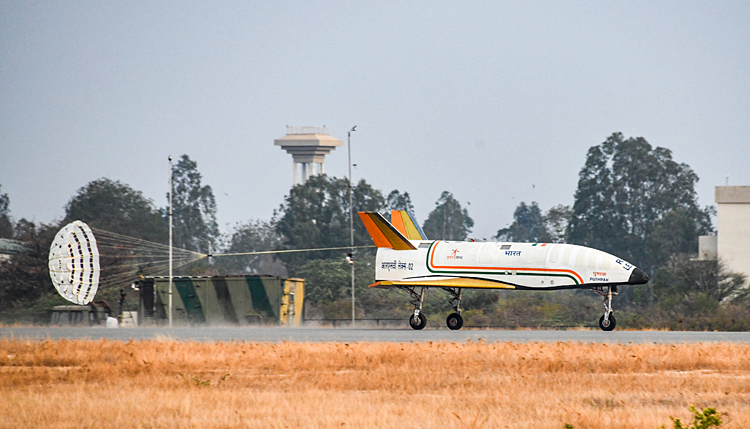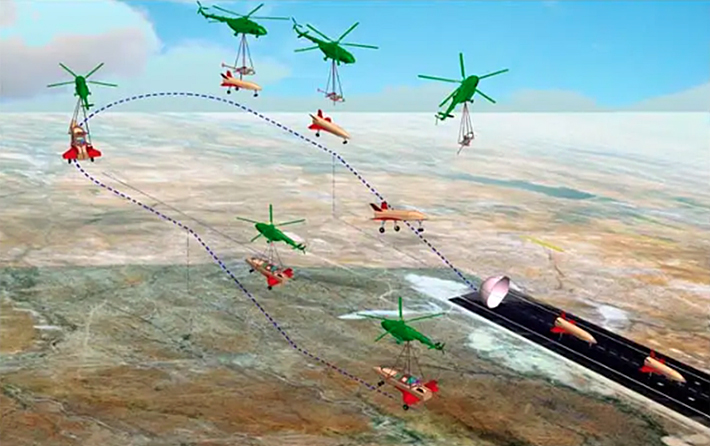INDIAN ARMED FORCES CHIEFS ON OUR RELENTLESS AND FOCUSED PUBLISHING EFFORTS

The insightful articles, inspiring narrations and analytical perspectives presented by the Editorial Team, establish an alluring connect with the reader. My compliments and best wishes to SP Guide Publications.

"Over the past 60 years, the growth of SP Guide Publications has mirrored the rising stature of Indian Navy. Its well-researched and informative magazines on Defence and Aerospace sector have served to shape an educated opinion of our military personnel, policy makers and the public alike. I wish SP's Publication team continued success, fair winds and following seas in all future endeavour!"

Since, its inception in 1964, SP Guide Publications has consistently demonstrated commitment to high-quality journalism in the aerospace and defence sectors, earning a well-deserved reputation as Asia's largest media house in this domain. I wish SP Guide Publications continued success in its pursuit of excellence.
- Prime Minister Modi Visits Punjab’s Adampur Air Base, Interacts with Airmen after Successful ‘Operation Sindoor’; Stern Message to Pakistan
- The layered Air Defence systems that worked superbly, the key element of Operation Sindoor
- Operation Sindoor | Day 2 DGMOs Briefing
- Operation Sindoor: Resolute yet Restrained
- India's Operation Sindoor Sends a Clear Message to Terror and the World – ‘ZERO TOLERANCE’
- Japan and India set forth a defence cooperation consultancy framework, talks on tank and jet engines
Another success for ISRO with the Autonomous Landing Experiment
ISRO achieved a major milestone in the area of Reusable launch vehicle (RLV) technology, through the RLV LEX-02 landing experiment, the second of the series.

Pushpak (RLV-TD), ISRO's winged vehicle, landed autonomously with precision on the runway after being released from an off-nominal position, adding another feather to ISRO's hat of success. ISRO achieved a major milestone in the area of Reusable launch vehicle (RLV) technology, through the RLV LEX-02 landing experiment, the second of the series, conducted at Aeronautical Test Range (ATR), Chitradurga in Karnataka on March 22. After the RLV-LEX-01 mission was accomplished last year, RLV-LEX-02 demonstrated the autonomous landing capability of RLV from off-nominal initial conditions at release from Helicopter. The RLV was made to undertake more difficult maneuvers with dispersions, correct both cross-range and down-range and land on the runway in a fully autonomous mode.
ISRO had successfully conducted the RLV LEX-01 on April 2, 2023, achieving the autonomous landing of a space vehicle.
The winged vehicle, named Pushpak, was lifted by an Indian Air Force(IAF) Chinook helicopter and was released from 4.5 km altitude. After release at a distance of 4 km from the runway, Pushpak autonomously approached the runway along with cross-range corrections. It landed precisely on the runway and came to a halt using its brake parachute, landing gear brakes and nose wheel steering system.


The mission was accomplished by Vikram Sarabhai Space Centre (VSSC) along with the Liquid Propulsion System Centre (LPSC) and the ISRO Inertial Systems Unit (IISU). Collaboration from various agencies including IAF, ADE, ADRDE and CEMILAC contributed to the success of this mission. S. Somanath, Chairman, ISRO Secretary, DOS, congratulated the team for the flawless execution of this complex mission. On the success of the landing experiment, Director VSSC Dr S. Unnikrishnan Nair mentioned that through this repeated success, ISRO could master the terminal phase maneuvering, landing and energy management in a fully autonomous mode, which is a critical step towards the future Orbital Re-entry missions.
Pioneering Autonomy in Space Exploration
This mission successfully simulated the approach and high-speed landing conditions of RLV returning from space. With this second mission, ISRO has re-validated the indigenously developed technologies in the areas of navigation, control systems, landing gear and deceleration systems essential for performing a high-speed autonomous landing of a space- returning vehicle. The winged body and all flight systems used in RLV-LEX-01 were reused in the RLV-LEX-02 mission after due certification/clearances. Hence this mission also demonstrated the reuse capability of flight hardware and flight systems. Based on the observations from RLV-LEX-01, the airframe structure and landing gear were strengthened to tolerate higher landing loads.
In a first in the world, a winged body had been carried to an altitude of 4.5 km by a helicopter and released for carrying out an autonomous landing on a runway during RLV LEX-01.
ISRO had successfully conducted the RLV Autonomous Landing Mission (RLV LEX-01) at the ATR, Chitradurga on April 2, 2023. The RLV was taken off by IAF's Chinook Helicopter as an underslung load and flew to a height of 4.5 km (above MSL). Once the predetermined pillbox parameters were attained, based on the RLV's Mission Management Computer command, the RLV was released in mid-air, at a down range of 4.6 km. Release conditions included 10 parameters covering position, velocity, altitude and body rates, etc. The release of RLV was autonomous. RLV then performed approach and landing maneuvers using the Integrated Navigation, Guidance & control system and completed an autonomous landing on the ATR air strip. With that, ISRO had successfully achieved the autonomous landing of a space vehicle.


The autonomous landing was carried out under the exact conditions of a Space Re- entry vehicle's landing-high speed, unmanned, precise landing from the same return path as if the vehicle arrived from space. Landing parameters such as ground relative velocity, the sink rate of landing gears, and precise body rates, as might be experienced by an orbital re-entry space vehicle in its return path, were achieved. The RLV LEX demanded several state-of-the-art technologies including accurate Navigation hardware and software, Pseudolite system, Ka-band Radar Altimeter, NavIC receiver, indigenous Landing Gear, Aerofoil honey-comb fins and brake parachute system.
In a first in the world, a winged body had been carried to an altitude of 4.5 km by a helicopter and released for carrying out an autonomous landing on a runway. RLV is essentially a space plane with a low lift to drag ratio requiring an approach at high glide angles that necessitates a landing at high velocities of 350 kmph. LEX utilised several indigenous systems. Localised Navigation systems based on pseudolite systems, instrumentation, and sensor systems, etc. were developed by ISRO. Digital Elevation Model (DEM) of the landing site with a Ka-band Radar Altimeter provided accurate altitude information. Extensive wind tunnel tests and CFD simulations enabled aerodynamic characterisation of RLV prior to the flight. Adaptation of contemporary technologies developed for RLV LEX makes other operational launch vehicles of ISRO more cost-effective.
Adaptation of contemporary technologies developed for RLV LEX is also aimed at making other operational launch vehicles of ISRO more cost-effective.
Reusable Launch Vehicle – Technology Demonstrator (RLV-TD) is touted to be one of the most technologically challenging endeavors of ISRO towards developing essential technologies for a fully reusable launch vehicle to enable low cost access to space. The configuration of RLV-TD is similar to that of an aircraft and combines the complexity of both launch vehicles and aircraft. The winged RLV-TD has been configured to act as a flying test bed to evaluate various technologies, namely, hypersonic flight, autonomous landing and powered cruise flight. In future, this vehicle will be scaled up to become the first stage of India's reusable two stage orbital launch vehicle.

RLV-TD consists of a fuselage (body), a nose cap, double delta wings and twin vertical tails. It also features symmetrically placed active control surfaces called Elevons and Rudder. This technology demonstrator was boosted to Mach no: 5 by a conventional solid booster (HS9) designed for low burn rate. The selection of materials like special alloys, composites and insulation materials for developing an RLV-TD and the crafting of its parts is very complex and demands highly skilled manpower. Many high technology machinery and test equipment were utilised for building this vehicle.
RLV-TD was successfully flight tested on May 23, 2016 from SDSC SHAR Sriharikota validating the critical technologies such as autonomous navigation, guidance & control, reusable thermal protection system and re-entry mission management.
Objectives of RLV-TD:
- Hypersonic aero thermodynamic characterisation of wing body
- Evaluation of autonomous Navigation, Guidance and Control (NGC) schemes
- Integrated flight management
- Thermal Protection System Evaluation
Reusability for the Future
In the pursuit of cost-effective space exploration, the concept of reusable landing vehicles has emerged as a solution to recover pricey rocket boosters utilised in spacecraft launches. These vehicles can be refurbished and reused for subsequent space flights, offering significant cost savings. Key components targeted for reuse include rocket stages, engines, and boosters, effectively reducing the overall expense of launches.
Typically, launch vehicles consist of multiple stages to propel payloads into specific orbits. However, the RLV features only two stages.
Equipped with added protective measures such as heat shields and grid fins, these reusable vehicles weigh more than their expendable counterparts due to the inclusion of additional avionics and propellant. The design of the spaceplane is also adapted to facilitate the recovery process.
Typically, launch vehicles consist of multiple stages to propel payloads into specific orbits. However, the RLV features only two stages. Once the fuel in the first stage is depleted, it is jettisoned, and the vehicle continues its journey using the second stage. The first stage then autonomously re-enters the atmosphere and lands at a predetermined location, ready for maintenance and future reuse.





